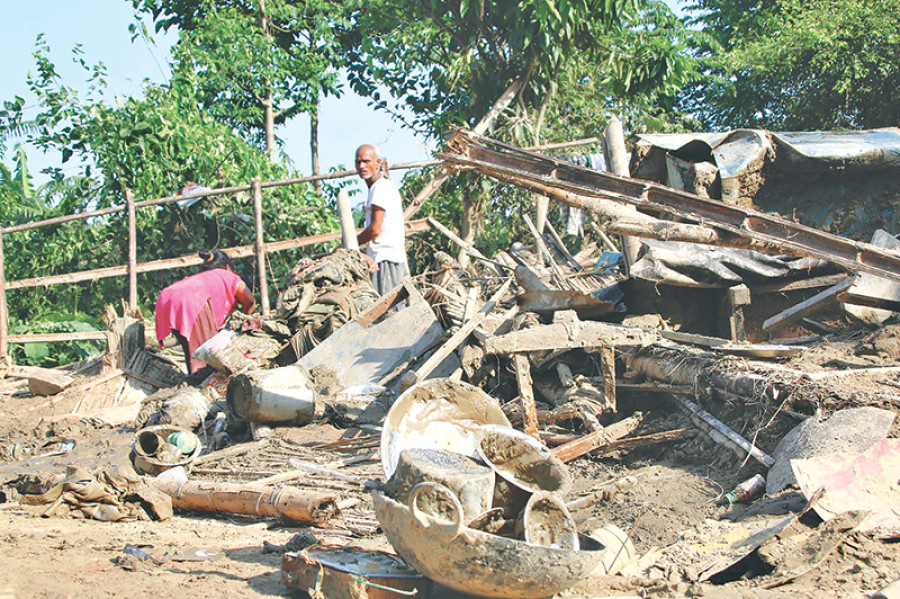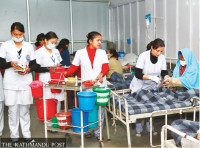Miscellaneous
Deluged
On Thursday, Sunita Rai of Itahari Submetropolitan City, Gairigaun-4, spent the whole day digging through her home, now caked with a thick layer of mud and debris.
Madhav Ghimire
On Thursday, Sunita Rai of Itahari Submetropolitan City, Gairigaun-4, spent the whole day digging through her home, now caked with a thick layer of mud and debris. If she’d become hopeful in the morning when she retrieved one gold earring, by the afternoon that hope was all but lost. Sunita lost several pieces of jewelry to the flood, and just about everything else she owned.
Like Sunita, locals of Gairigaun—most of who lost all, apart from the clothes they were wearing, to the floods—have been desperately searching what remains of their homes in hopes of retrieving something, anything. They are currently residing in a makeshift relief camp nearby, where their day begins and ends with the search.
In Gairigaun itself, about 250 houses were damaged in the flood; and more than 500 locals have been displaced. Hundreds of electric appliances, such as fans, refrigerators and televisions are buried in the mud here. What clothes and food the waters didn’t sweep away are now unusable.
In the neighbouring village, Itahari-3, 130 of its 300 houses were inundated.
A local, Shankar Rai, claims that he escaped with his life by climbing up to the roof of his house when the waters from the Budhi and Sehera rivers began gushing into the lower floors. “As I scrambled onto the rooftop, I saw the flood rise, sweeping away so many people, so many things,” he says. One of his neighbours is still missing.
According to authorities, the total number of lives lost due to the flood has reached 12 in Sunsari district, while six people are missing. The Eastern Regional Police Office, based in Biratnagar, on Thursday, said that 46 people have died in the eastern region, while 15 are still missing. About 35,000 homes were damaged in the floods triggered by the incessant rainfall since August 11.
Underwhelming relief efforts
In districts like Morang and Jhapa, while people have begun returning to their homes now that the waters have receded, the relief efforts have been largely underwhelming. Many—including those who have moved back into their own homes—are without food to eat or clothes to change into.
Tek Bahadur Darnal of Jhapa, Rural Muncipality-3, lost his wife Kamala and his three-year old daughter to the flood. He is currently performing kriya at a relative’s home.
Meanwhile, Mohammed Abdul, of Rangeli Municipality-2, is currently residing in a makeshift shelter beside the Koshi Highway. “There is nothing but mud inside our home and we have not moved back because we are unsure if the danger has passed,” he says, “But we don’t feel safe here either. This area is teeming with snakes, but we have little other options.” For the past week, Abdul’s family has been surviving on beaten or puffed rice alone.
Same is the case with Jogindra Rajbanshi’s family. A resident of Dhanpalthan, Morang, Rajbanshi has managed to erect a makeshift shelter of bamboo and tarpaulin, but it hasn’t brought him any peace. “Mosquitoes, fear of snakebite, and the smell of dead cattle keep us awake all night,” he says.
Meanwhile, the locals of the neighbouring Budhiganga, Morang, are visibly enraged by the government’s snail-paced response to the disaster. “Even after a week since the flood, no relief has made its way to us,” they say. They took to the streets and called a one-hour long vehicular strike (chakkajam) along the Koshi highway on Wednesday to draw attention to their plight. In Morang alone, about 11,000 families were rendered homeless by the flood. Ram Prasad Acharya, Chief District Officer of Morang, however, maintains that the relief works are in full swing. “The relief operations are being carried out through the elected local level representatives,” he told the Post.
Acharya’s claim comes in the face of locals becoming increasingly irate at the lack of relief received in the makeshift camps, many of which are reporting an increasing number of ailments like the common cold, diarrhea, typhoid and skin-related conditions. The Morang District Health Office has informed that teams of physicians are currently working in the field to control potential health hazards. The DHO also confirmed that about a dozen cases of snake-bites have been registered over the past week.
Fear for the future
While the displaced residents of the five districts in Tarai’s eastern belt grapple with the devastation this week’s floods have left in its wake, they remain acutely aware of the long-term impact of the disaster. It has been estimated that the floods have damaged agricultural products approximately worth Rs 4 billion rupees in the region, nearly half of the estimated Rs 8.11 billion worth of agricultural losses in the entire country.
According to the spokesperson of the Regional Agriculture Directorate-Biratnagar, Rajendra Upreti, the floods have damaged paddy worth Rs 2.5 billion, fish worth approximately Rs 1 billion, and vegetables worth Rs 316 million. Nearly 40,000 hectares of farmland were inundated by floods in the region. The estimations, according to Upreti, are preliminary figures and will rise in the coming days.
In Siraha alone, the total loss to agriculture is estimated at Rs 1.15 billion. In Morang, the loss has been estimated at Rs 0.67 billion.
At the Sunsari-Morang Industrial Corridor, one of Nepal’s key industrial regions, too, the damage has been widespread.
The industries in the Industrial Corridor have ceased operations after being partially submerged in water. Much of the finished products, raw materials and production equipment went under during the flood, and this once bustling region has ground to a halt.
“The industries in the corridor have suffered damages amounting to around Rs 2 billion,” Mukesh Upadhyay, the chairman of the Morang Chamber of Commerce, said. “While some factories have begun small scale productions, a majority of them will likely remain closed for up to a month. But given the widespread devastation to all sectors of the local economy, it is impossible to gauge as of now what the actual damages will amount to.”




 7.12°C Kathmandu
7.12°C Kathmandu










